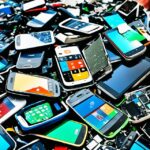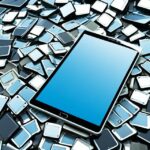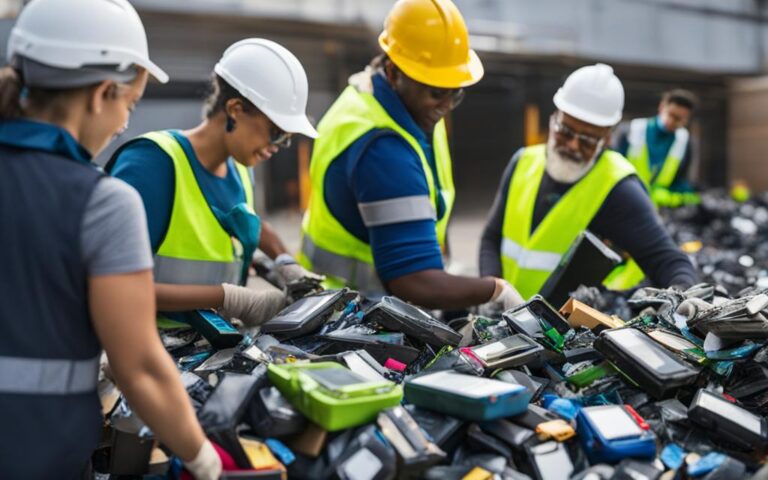Bridging the Digital Divide with Recycled Phones and Tablets
Imagine a world where everyone has equal opportunities to access technology and connect with the digital world. Unfortunately, in the United Kingdom, the digital divide remains a significant barrier, with millions of households lacking in-home internet access and computer devices. This divide creates inequalities in accessing essential services, education, and job opportunities.
To address this issue and ensure that no one is left behind, innovative solutions are emerging, such as recycling and repurposing phones and tablets. By giving a second life to these devices, we can bridge the digital divide and empower individuals and communities.
The Impact of the Digital Divide on Healthcare
The digital divide has a significant impact on healthcare, particularly in the context of telemedicine. Research has shown that telehealth is nearly as effective as in-person primary care visits. However, millions of households in the US lack access to the necessary devices and internet connectivity needed to access these convenient and critical healthcare services at home. This lack of access further exacerbates health inequities and prevents individuals from obtaining the care they need.
“The digital divide creates a deep chasm in healthcare access, preventing individuals from receiving the care they deserve. Without the necessary devices and internet connectivity, patients are denied the convenience and benefits of telemedicine. This not only widens the gap in healthcare disparities but also hinders the potential for improved patient outcomes”
Telemedicine has proven to be an effective and convenient mode of healthcare delivery, offering a wide range of advantages such as reduced travel time, decreased healthcare costs, and increased accessibility for individuals with mobility limitations. The ability to consult doctors remotely, receive prescriptions, and access medical advice from the comfort of one’s home has revolutionized the provision of healthcare services.
However, the digital divide restricts millions of individuals, especially those in rural and underserved communities, from enjoying these benefits. Limited access to electronic devices, such as smartphones, tablets, or computers, hinders the adoption of telemedicine. Furthermore, inadequate or lack of internet connectivity in certain areas makes it impossible for individuals to connect with healthcare providers through telehealth platforms.
The implications of the digital divide on healthcare access are far-reaching. Patients in areas without reliable internet access or proper devices face significant barriers in reaching healthcare providers, resulting in delayed or missed appointments, reduced access to specialist care, and limited follow-up opportunities for chronic conditions. Moreover, individuals with limited resources may be forced to rely on emergency care instead of preventive and regular primary care, further straining healthcare systems.
“Without bridging the digital divide, we risk leaving vulnerable populations behind, perpetuating health inequities, and compromising the overall well-being of our communities.”
Telemedicine and Health Inequities
The digital divide intensifies health inequities by disproportionately affecting marginalized populations. According to a study conducted by the Pew Research Center, certain demographic groups, such as seniors, individuals with lower income, and those with lower levels of education, are more likely to face barriers to internet access and device ownership.
A lack of telemedicine access perpetuates existing disparities in healthcare access and outcomes. Individuals facing socioeconomic challenges may struggle to afford necessary devices or broadband subscriptions, forcing them to prioritize other needs over healthcare. As a result, they may delay seeking medical attention or forego preventive care, leading to the progression of diseases and worsening health outcomes.
Furthermore, communities with limited access to healthcare facilities, such as rural areas, can benefit greatly from telemedicine solutions. However, without reliable internet access, these communities miss out on the advantages of telehealth, exacerbating disparities in healthcare access and outcomes between urban and rural regions.
The Need for Solutions
The digital divide in healthcare access demands urgent solutions to ensure equitable and accessible healthcare for all. Bridging the gap requires collaboration between government entities, healthcare organizations, technology companies, and community-based initiatives.
Efforts should focus on:
- Expanding broadband infrastructure: Investing in the development of reliable and high-speed broadband networks in underserved areas is essential to enable telemedicine adoption and equal access to healthcare services.
- Device availability: Providing affordable or subsidized devices to individuals who lack the means to purchase them allows for participation in telemedicine consultations and access to medical resources.
- Education and digital literacy: Offering digital literacy programs ensures that individuals are equipped with the necessary skills to navigate telemedicine platforms and leverage digital resources effectively.
- Policy support: Implementing policies that prioritize closing the digital divide and integrating telemedicine into healthcare systems can facilitate widespread adoption and ensure equal access to care.
The image above represents a patient utilizing telemedicine, highlighting the potential of technology to bridge the digital divide and provide accessible healthcare to all.
| Impacts of the Digital Divide on Healthcare | Solutions |
|---|---|
| Restricted access to telemedicine services | Expand broadband infrastructure |
| Delayed or missed appointments | Provide affordable devices to individuals |
| Reduced access to specialist care | Offer digital literacy programs |
| Increased reliance on emergency care | Implement supportive policies |
In conclusion, the digital divide presents significant challenges to healthcare access, particularly in the context of telemedicine. It perpetuates health inequities, limiting individuals’ ability to benefit from convenient and critical healthcare services. By investing in broadband infrastructure, making devices more affordable and accessible, providing education and support, and implementing supportive policies, we can bridge the digital divide and ensure equitable healthcare access for all.
Understanding the Digital Divide
The digital divide is a complex issue influenced by various factors such as socio-economic status, geographic location, access to broadband infrastructure, and awareness of the benefits of connectivity. In the United States alone, an estimated 11.7 million households lack in-home internet access, while 5.5 million households do not have a computer. This stark lack of access poses significant challenges and hampers individuals and families from pursuing education, accessing well-paying jobs, and fully participating in society.
To comprehend the gravity of the digital divide, it’s crucial to consider the impact it has on different aspects of life. Take education, for instance. Without in-home internet access and a computer, students face difficulty completing assignments, accessing online resources, and participating in digital learning initiatives. This challenge directly affects their educational outcomes and prospects for future success.
Furthermore, the digital divide perpetuates existing socio-economic inequalities. Those without access to technology are unable to tap into the wealth of resources available online, hindering their ability to search for well-paying jobs, access financial services, and improve their socio-economic status. As a result, the digital divide exacerbates and reinforces disparities that already exist in society.
Broadband Infrastructure and Geographic Disparities
One of the significant contributing factors to the digital divide is the lack of adequate broadband infrastructure, particularly in rural and underserved areas. High-speed internet access is essential for individuals to fully participate in the digital world. However, the availability of reliable and affordable broadband varies across regions, leaving many communities disconnected.
The table below outlines the disparities in broadband infrastructure across different geographical areas:
| Geographic Area | Percentage of Households with Broadband |
|---|---|
| Rural Areas | 70% |
| Urban Areas | 83% |
| Suburban Areas | 89% |
A lack of broadband infrastructure poses a significant barrier to bridging the digital divide, as individuals without access to high-speed internet are unable to take full advantage of online opportunities and resources.
Addressing Socio-Economic Disparities
Socio-economic status is another critical factor that influences the digital divide. Affordability plays a crucial role in determining who has access to in-home internet and computers. Achieving digital inclusion requires addressing the financial barriers that prevent individuals and families from obtaining the necessary technology.
“The digital divide is not solely about access to technology, but also about access to knowledge and opportunity.” – Tim Berners-Lee
Reducing the cost of technology and internet services through subsidies, discounted programs, and government initiatives can help foster greater access and participation. Additionally, promoting digital literacy programs that educate individuals about the benefits of connectivity can empower them to make informed decisions and fully utilize available resources.
Image: Broadband infrastructure is crucial for bridging the digital divide.
In conclusion, understanding the digital divide requires recognizing the various factors that contribute to it, including socio-economic status, broadband infrastructure, geographic disparities, and education. Addressing these inequalities will require multifaceted strategies that encompass affordable access, robust connectivity, and comprehensive digital literacy initiatives. By bridging the digital divide, individuals and communities can unlock greater opportunities, participate fully in society, and create a more inclusive and equitable future for all.
Addressing the Digital Divide Through Recycling
Recycling plays a crucial role in bridging the digital divide. It offers an opportunity to repurpose and donate gently used devices to individuals and households without access to technology, providing them with the necessary tools for connectivity. Compudopt, a nonprofit organization, is at the forefront of this movement, refurbishing devices and distributing them to communities in need.
By recycling and donating devices, we not only reduce electronic waste but also empower individuals and communities with internet access. These refurbished devices enable users to utilize online resources, communicate, learn, and connect with others. They open doors to educational opportunities, job prospects, and access to essential services.
“Recycling is not just about reducing waste; it is about transforming lives.”
Organizations like Compudopt not only provide refurbished devices but also contribute to bridging the digital divide by bringing high-speed internet into homes. By addressing the lack of internet access, these initiatives ensure that everyone has the opportunity to benefit from digital resources and participate in the digital world.
Recycling Devices: A Sustainable Solution
When we recycle devices, we contribute to a more sustainable future. The process of refurbishing and reusing devices significantly reduces electronic waste, conserves resources, and minimizes the environmental impact associated with the production of new devices.
Furthermore, recycling devices aligns with the principles of the circular economy, promoting the reuse and longevity of products. It extends the lifespan of devices, reducing the need for constant manufacturing and reducing the consumption of finite resources. By embracing recycling as a solution, we can address both the digital divide and environmental concerns simultaneously.
Empowering Communities through Collaboration
Addressing the digital divide requires collaboration among individuals, organizations, and governments. By working together, we can pool resources, knowledge, and expertise to make a greater impact. Initiatives like Compudopt’s device refurbishment program showcase the power of collaborative efforts in bridging the digital divide.
The collaboration between recycling initiatives, nonprofits, and corporate partners ensures a holistic approach. It not only provides devices but also focuses on digital literacy training, internet connectivity, and ongoing support to ensure individuals and communities can fully utilize the benefits of technology.
The Impact of Recycling on Connectivity
By addressing the digital divide through recycling, we empower individuals and communities by providing them with the necessary tools for connectivity. The benefits of recycling devices go beyond bridging the digital divide; they extend to education, healthcare, economic opportunities, and social inclusion.
Through initiatives like Compudopt, refurbished devices have transformed lives and opened doors for individuals who may have previously been left behind. It is an inspirational journey where technology bridges the gap and brings people closer to their dreams and aspirations.
The Impact of Recycled Devices
Recycled devices have a profound impact on individuals and communities, offering new opportunities for education, connectivity, and personal growth. By providing access to technology, recycled devices empower individuals to pursue educational goals, apply for jobs, access online resources, and fully participate in the digital world.
One inspiring example of the transformative power of recycled devices is the work of The Turing Trust, a charity dedicated to bridging the digital divide in schools. The charity refurbishes donated IT equipment and sends it to schools in Ghana and Malawi, where students often have limited or no access to computers. These devices not only provide students with their first experience using a computer but also open doors to a world of information, knowledge, and opportunities previously out of reach.
This impactful initiative demonstrates how the donation of computers and other recycled devices can positively transform lives and create a more equitable future. Through access to educational resources and connectivity, students are empowered to develop essential digital skills, expand their horizons, and pursue brighter prospects.
Empowering Education
Recycled devices play a crucial role in empowering education by providing students with the tools they need to succeed in today’s digital landscape. With access to computers, students can research and explore a vast array of subjects, access online libraries and educational platforms, collaborate with peers, and gain vital digital literacy skills. The opportunities for learning are endless, enabling students to expand their knowledge and unlock their full potential.
Enabling Connectivity
In addition to education, recycled devices also enable connectivity, bridging the gap between individuals and the wider digital world. Through internet access, individuals can connect with others, access valuable resources, and participate in online communities. Whether it’s using social media to stay connected with friends and family, exploring new career opportunities, or accessing essential services, connectivity opens doors and creates pathways for personal and professional growth.
Recycled devices bring education, connectivity, and opportunities to individuals and communities, breaking down barriers and empowering lives.
| Benefits of Recycled Devices | Examples |
|---|---|
| Access to education and online resources | The Turing Trust providing computers to schools in Ghana and Malawi |
| Opportunities for personal and professional growth | Individuals applying for jobs, expanding their horizons |
| Increased connectivity and participation in the digital world | Connecting with friends and family, accessing online services |
Recycled devices bring education, connectivity, and opportunities to individuals and communities, breaking down barriers and empowering lives. By supporting initiatives that refurbish and distribute recycled devices, we can make a significant difference in narrowing the digital divide and ensuring that everyone has equal access to the benefits of technology.
Overcoming the Digital Divide through Collaboration
Overcoming the digital divide is a collective effort that requires collaboration not only within the healthcare industry but also across different sectors. Healthcare providers have a crucial role to play in addressing the digital divide by educating themselves about its impact on their patients. It is essential for healthcare professionals to engage in open dialogues with patients, understanding their digital resources and limitations.
By actively listening to patients’ needs, healthcare providers can refer them to organizations like Compudopt that offer assistance in bridging the digital gap. Compudopt provides free devices, internet connectivity, and technology training to families, ensuring they have access to necessary resources, including healthcare services.
“Collaboration is the key to bridging the digital divide in healthcare. By working together, we can empower individuals and communities to overcome barriers and gain access to essential resources.”
However, addressing the digital divide requires the involvement of other stakeholders as well. Individuals and corporations can contribute by recycling their used devices, supporting nonprofit organizations, and volunteering their time and expertise in bridging the gap in digital access.
The Power of Collaboration
Collaboration between healthcare providers, organizations like Compudopt, and other stakeholders is crucial for implementing effective connectivity solutions. By pooling resources, expertise, and knowledge, we can create a network of support that ensures healthcare services and information are accessible to all, regardless of their digital capabilities.
Together, we can develop innovative strategies, such as recycling and repurposing devices, to provide individuals and communities with the tools they need for connectivity. By working collaboratively, we can overcome the challenges posed by the digital divide and create a more inclusive healthcare system.
Collaboration also extends beyond healthcare. Partnerships with telecommunications companies, government agencies, and educational institutions can help expand broadband infrastructure and promote digital literacy. By coming together, we can build a stronger and more equitable society.
Joining Forces for a Connected Future
It is inspiring to see the impact of collaboration in bridging the digital divide. By working together, we can empower individuals and communities, ensuring that everyone has equal opportunities for connectivity and access to essential resources.
Through partnerships, recycling initiatives, and volunteer efforts, we can create a connected future where healthcare services, education, and opportunities are accessible to all. Let us seize this opportunity to collaborate and make a difference in the lives of those affected by the digital divide.
Empowering Youth through Connectivity
The digital divide has a profound impact on young people, limiting their access to educational opportunities and future prospects. Without internet access, they are unable to fully engage in online learning, access educational resources, or develop the digital skills necessary for success in today’s digital era. However, initiatives like the After School Access Project by UScellular are working to close this connectivity gap and empower youth.
After School Access Project: Bridging the Gap
UScellular’s After School Access Project is a groundbreaking initiative that aims to provide internet access to youth who would otherwise be left without. With a pledge of up to $13 million in mobile hotspots and service to nonprofits, the project seeks to break down the barriers created by the digital divide and unlock the potential of young minds.
By providing young people with access to the internet, the After School Access Project ensures that they can complete homework, explore new educational opportunities, and develop the digital literacy skills needed to thrive in the modern world.
Through this project, UScellular is taking a proactive approach to address the digital divide and create a more inclusive society. By equipping youth with the necessary tools and resources, they are leveling the playing field and allowing young individuals from all backgrounds to pursue their dreams.
The Transformative Power of Connectivity
Access to the internet has the power to transform the lives of young people. It opens doors to a world of knowledge and resources, enabling them to expand their horizons, explore new subjects, and access educational materials that were once out of reach.
With internet access, youth can connect with mentors and peers, collaborate on projects, and gain insights from experts in various fields. They can access online courses, tutorials, and educational platforms, augmenting their learning experiences beyond the traditional classroom setting.
Image: Youth engaging with technology and embracing the power of connectivity
Unlocking Potential for a Brighter Future
By bridging the digital divide and providing access to the internet, the After School Access Project is empowering youth to unlock their full potential. With connectivity, they can pursue their passions, gain knowledge, and develop the skills necessary for success in an increasingly digitalized world.
Through initiatives like the After School Access Project, we can ensure that no young person is left behind due to a lack of internet access. Together, we can bridge the digital divide and create a future where every youth has the opportunity to thrive and achieve their dreams.
Conclusion
Bridging the digital divide requires a collaborative effort from organizations, communities, and individuals alike. By recycling and repurposing devices, providing internet access, and offering digital literacy training, we can ensure that everyone has equal opportunities for connectivity and access to vital resources. Initiatives like Compudopt and the After School Access Project are making commendable strides in narrowing the digital divide and empowering individuals, especially the youth, for a brighter future.
Through the donation of recycled devices, individuals and households without access to technology can now embrace the benefits of connectivity. They can pursue educational opportunities, access online resources, apply for jobs, and fully participate in the digital world. Organizations like the Turing Trust send refurbished computers to schools in Ghana and Malawi, transforming the lives of students who have never had the opportunity to use a computer before.
However, it is not enough to rely solely on recycling and repurposing devices. Collaboration within the healthcare industry and beyond is crucial in overcoming the digital divide. Healthcare providers must educate themselves about the impact of the digital divide on their patients and engage in open dialogues to understand their digital resources. Referring patients to organizations like Compudopt can provide the necessary assistance they need. Other stakeholders, including individuals and corporations, can contribute by recycling their used devices, supporting nonprofit organizations, and volunteering to help bridge the gap in digital access for all.
Addressing the digital divide also means recognizing the profound impact it has on young people. The After School Access Project by UScellular aims to close the connectivity gap for youth by providing mobile hotspots and service to nonprofits. This initiative ensures that young individuals have access to the internet, enabling them to complete homework, access educational resources, and develop the skills necessary for success in the digital era. By empowering youth through connectivity, we are investing in a future where everyone, regardless of their background, has equal opportunities to thrive in an interconnected world.
FAQ
What is the digital divide?
The digital divide refers to the gap between those who have access to technology and the internet and those who do not. It is a disparity that prevents individuals and communities from fully participating in the digital world.
How does the digital divide impact healthcare?
The digital divide has a significant impact on healthcare as it limits access to telemedicine and other digital healthcare services. This lack of access further exacerbates health inequities and prevents individuals from obtaining the care they need.
What factors contribute to the digital divide?
The digital divide is influenced by factors such as socio-economic status, geographic location, access to broadband infrastructure, and education on the benefits of connectivity.
How can recycling bridge the digital divide?
Recycling can play a crucial role in bridging the digital divide by repurposing and donating gently used devices to communities in need. This allows individuals without access to technology to gain the necessary tools for connectivity.
What impact do recycled devices have?
Recycled devices have a significant impact on individuals and communities by providing access to technology. They enable individuals to pursue education, apply for jobs, access online resources, and participate in the digital world.
How can we overcome the digital divide?
Overcoming the digital divide requires collaboration within the healthcare industry and beyond. Healthcare providers can educate themselves about the issue, engage in dialogues with patients, and refer them to organizations that provide assistance. Individuals and corporations can contribute by recycling their used devices and supporting nonprofit organizations.
How does the digital divide affect young people?
The digital divide affects young people profoundly, hindering their access to educational opportunities and future prospects. Initiatives like the After School Access Project aim to close the connectivity gap for youth by providing them with mobile hotspots and internet service.
What is the importance of collaboration in bridging the digital divide?
Collaboration is crucial in bridging the digital divide. By working together, organizations, communities, and individuals can recycle and repurpose devices, provide internet access, and offer digital literacy training to ensure equal opportunities for connectivity and access to resources.















